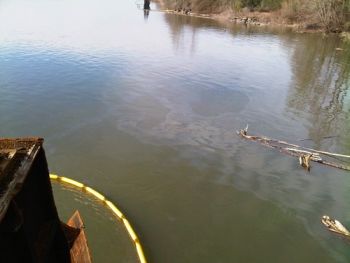
Publisher:
Bonnie King
CONTACT:
Newsroom@Salem-news.com
Advertising:
Adsales@Salem-news.com

~Truth~
~Justice~
~Peace~
TJP
Jan-31-2011 22:27

 TweetFollow @OregonNews
TweetFollow @OregonNews
Polychlorinated Biphenyls (PCBs) Detected in Oil Leaking from Derelict Vessel
Salem-News.comA primary and secondary containment area has now been established around the vessel.
 Oil sheen around the derelict vessel Davey Crockett |
(PORTLAND, Ore.) - Follow up tests of oil samples taken from a 431-foot derelict vessel, Davy Crockett, have detected low levels of polychlorinated biphenyls (PCBs).
Washington State Dept. of Ecology received reports Thursday of a light, non-recoverable sheen at mile marker 115 on the Columbia River, the site of the vessel. Oil samples taken from the engine room hold of the vessel detected approximately 3.44 parts per million (ppm) of PCBs. Coast Guard, Ecology, Oregon Dept. of Environmental Quality and other agencies responded and are working to cleanup oil and monitor the vessel. Federal regulations for PCBs in oil require specialized handling and disposal for levels at 50 ppm or greater.
Environmental and public health agencies’ regulations vary as to what constitutes acceptable concentrations of PCBs. Federal regulations require that water containing PCBs must be below 0.003 ppm to be discharged to navigable waters. One part per million is roughly the equivalent of one teaspoon per 1,300 gallons.
“The PCB-containing oil released from the barge is not an immediate public health risk,” said David McBride, a toxicologist with the Washington State Dept. of Health (DOH). “Existing advisories warn people to not eat any freshwater shellfish in the lower Columbia River, due to pre-existing contamination from historic releases of PCB.”
"We remind people to avoid direct contact with any oily sheen they may encounter in the water,” said Michael Heumann, an epidemiologist with the Public Health Division at the Oregon Health Authority in Portland.
“Any release of PCBs to the Columbia River is a concern, because it adds to existing PCB contamination in the river,” said Jim Sachet, state on-scene coordinator for the Washington Dept. of Ecology and a member of the unified command team managing the response. “Our main priorities are the safety of the responders and to prevent additional releases of oil.”
A primary and secondary containment area has been established around the vessel, consisting of approximately 18,000 feet of sorbent boom and 2,800 feet of hard boom.
Incident managers have consulted with federal and state environmental agencies, state and county public health agencies and other interested parties regarding the potential effects of the PCBs added to the river on public health and the environment.
For more information on PCBs and their health effects, see http://www.epa.gov/epawaste/hazard/tsd/pcbs/index.htm;
Source: U.S. Coast Guard news release
Articles for January 30, 2011 | Articles for January 31, 2011 | Articles for February 1, 2011



Quick Links
DINING
Willamette UniversityGoudy Commons Cafe
Dine on the Queen
Willamette Queen Sternwheeler
MUST SEE SALEM
Oregon Capitol ToursCapitol History Gateway
Willamette River Ride
Willamette Queen Sternwheeler
Historic Home Tours:
Deepwood Museum
The Bush House
Gaiety Hollow Garden
AUCTIONS - APPRAISALS
Auction Masters & AppraisalsCONSTRUCTION SERVICES
Roofing and ContractingSheridan, Ore.
ONLINE SHOPPING
Special Occasion DressesAdvertise with Salem-News
Contact:AdSales@Salem-News.com

Terms of Service | Privacy Policy
All comments and messages are approved by people and self promotional links or unacceptable comments are denied.
[Return to Top]
©2025 Salem-News.com. All opinions expressed in this article are those of the author and do not necessarily reflect those of Salem-News.com.